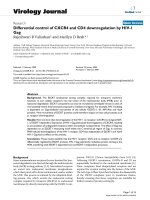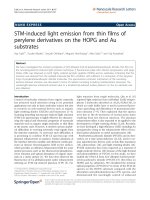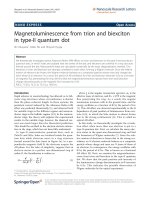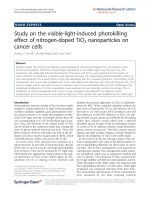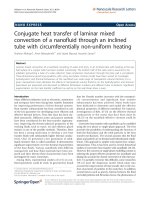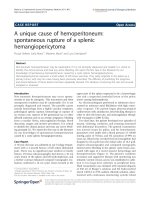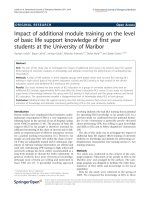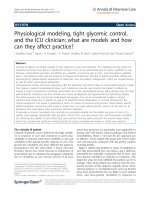Kanagarajan et al. Organic and Medicinal Chemistry Letters 2011, 1:8 doc
Bạn đang xem bản rút gọn của tài liệu. Xem và tải ngay bản đầy đủ của tài liệu tại đây (353.88 KB, 7 trang )
ORIGINAL Open Access
In vitro microbiological evaluation of 1,1’-(5,5’-
(1,4-phenylene)bis(3-aryl-1H-pyrazole-5,1-(4H,5H)-
diyl))diethanones, novel bis acetylated pyrazoles
Vijayakumar Kanagarajan
1,2
, Muthuvel Ramanathan Ezhilarasi
2
and Mannathusamy Gopalakrishnan
2*
Abstract
Novel 1,1’-(5,5’-(1,4-phenylene)bis(3-aryl-1H-pyrazole-5,1-(4H,5H)-diyl))diethanones 7-12 were tested for their
antimicrobial activity by disc diffusion and twofold serial dilution method against the tested bacterial and fungal
strains. Compounds 7 against Micrococcus luteus, 8 against b-Heamolytic streptococcus, M. luteus, Klebsiella
pneumonia, Microsporum gypseum, 9 against Staphylococcus aureus, Shigella flexneri, Vibreo cholerae, Pseudomonas
aeruginosa, Aspergillus flavus, Mucor indicus, 10 against Salmonella typhii, S. flexneri, M. gypseum, 11 against K.
pneumonia, M. gypseum, 12 against K. pneumonia, and M. gypseum show superior zone of inhibitions and exhibited
excellent antibacterial and antifungal activities at a MIC value of 6.25 μg/mL. Moreover, all the tested compounds
7-12 revealed promising antitubercular activity against Mycobacterium tuberculosis H
37
Rv and INH-resistant
M. tuberculosis. Compounds 8 against M. tuberculosis and 11 against INH-resistant M. tuberculosis exhibited the
percentage of reduction in RLU at 89 and 85%, respectively.
Keywords: bisacetylated pyrazoles, in situ acetylation, antibacterial activity, antifungal activity; antitubercular activity
1. Introduction
Mycobacterium tuberculosis (MTB) is a pathogenic bacter-
ial species in the genus Mycobacterium and is the causa-
tive agent of most cases of tuberculosis. Tuberculosis is a
common and often deadly infectious disease in humans
[1,2]. Tuberculosis is the most common opportunistic dis-
ease in persons infected with human immunodeficiency
virus [3]. The genome of MTB is rich in lipid-metabolizing
and P450 enzymes. The cell en velope of MTB is unique
and is associated with its pathogenicity [4]. Mycolic acids
are the major constituents of the protective barrier of cell
envelope of MTB and are essential for survival, virulence,
and antibiotic resistance [5]. Inhibitors of mycolic acid
biosynthesis, such as isoniazid (INH), ethambutol (EMB),
and pyrazinamide (PZA), are still in the frontline of antitu-
bercular drugs [6].
The discovery of the norfloxacin plays an important role
in structure-activity relationships analysis of the fluoroqui-
nolonic nucleus A-D, (Scheme 1) which led to the
development of new derivatives with better solubility,
higher antimicrobial activit y, prolonged serum half-life,
fewer adverse side effe cts, and both oral and parenteral
routes of administration [7-9]. Naturally occurring bacter-
ial DNA gyrase inhibitor such as novobiocin, a coumarin
derivative E (Scheme 1), is known as antib acterial agent s
[10]. The coumarin drug inhibits ATPase activity of DNA
gyrase by competing with ATP for binding to the subunit
B of the enzyme. Owing to side effects, no pharmaceuti-
cally useful drug has bee n derived from the coumarin s
[11]. Although huge efforts have been dedicated to find a
potent antibacterial agents that can overcome bacterial
resistance, promi sing le ad structures of DNA gyrase and
topoisomerase IV enzyme inhibitors with novel mechan-
isms of action have not been found [12]. This reflects the
inherent difficulties associated with the discovery and clin-
ical testing of new candidates and the lack of significant
pharmaceutical indust ry research in this area. Hence, the
discovery and development of new drugs that effectively
combat TB are accorded a great importance. In recent
years, interest in pyrazoles has increased significantly
because of their proven usefulness as intermediates in the
preparation of new pharmaceuticals and agrochemicals
* Correspondence:
2
Synthetic Organic Chemistry Laboratory, Department of Chemistry,
Annamalai University, Annamalainagar 608 002, Tamil Nadu, India
Full list of author information is available at the end of the article
Kanagarajan et al. Organic and Medicinal Chemistry Letters 2011, 1:8
/>© 2011 Kanagarajan et al; licensee Springer. This is an Open Access article distributed under the terms of the Creative Comm ons
Attribu tion License ( which permits unrestricted use, distribution, and repro duction in
any medium, provided the original work is properly cited.
[13-15]. Also, pyrazole derivatives F and G (Scheme 1)
were identified as a new class of DNA gyrase and topoi-
somerase IV enzyme inhibitors [16]. Besides these, amides
are well known for their therapeutic values since the
amide group is an important pharmacophore. Antibiotics
such as penicillins and cephalosporins have an amide
group. The resistance toward available drugs is rapidly
becoming a major worldwide problem. The necessity to
design new compounds to overcome this resistance has
become one of the most important areas of research
today. Owing to our interest in synthesizing fascinating
biologically active structurally diverse heterocycles [17-20],
we recently reported the clean production o f 1,1’-(5,5’-
(1,4-phenylene)bis(3-aryl-1H-pyrazole-5,1- (4H,5H)-diyl))
diethanones, a novel series of bis pyrazole derivatives using
sodium acetate/ace tic anhydride triggered by ultrasound
irradiation [21], which accelerated the chemical reaction
and mass transferred via the process of acoustic cavitation
[22]. Extending the research in this area, we decided to
investigate the antibacterial, antifungal, and antitubercular
activities of the target compounds with the hope to
develop some promising antimicr obial and antimycobac-
terial agents.
2. Experimental
2.1 Chemistry
Performing TLC assessed the reactions and the purity of
the products. All the reported melting points are taken in
open capillaries and were uncorrected. Sonicati on is per-
formed on a Life Care-Fast Ultrasonic system (Life Care
Equipments Pvt. Ltd., Mumbai, India) oper ating at a fre-
quency of 45 kHz. The reaction flask is located in the
maximum energy area in the bath and the addition or
removal of water controlled the temperature of the water
bath. IR spectra are recorded in KBr (pellet forms) on a
Thermo Nicolet-Avatar-330 FT-IR spectrophot ometer
(Thermo Fisher Scientific Inc., Waltham, MA, US) and
note worthy absorption values (cm
-1
) alone are listed.
1
H
and
13
C NMR spectra are recorded at 40 0 and 100 MHz,
respectively, on Bruker AMX 400 NMR spectrometer
(Bruker Biospin International, Ag, Aegeristrasse, Switzer-
land) using CDCl
3
as solvent. The ESI +ve MS spectra
are recorded on a Varian Saturn 2200 MS spectrometer
(Varian Inc., Palo Alto, USA). Satisfactory microanalyses
are obtained on Carlo Erba 1106 CHN analyzer (Thermo
Fisher Scientific Inc., Waltham, MA, US). By adopting
the literature precedent, bis chalcones 1-6 [23] and 1,1’-
(5,5’-(1,4-phenylene)bis(3-aryl-1H-pyrazole-5,1-(4H, 5H)-
diyl))diethanones 7-12 [21] are prepared.
2.2. Microbiology
All the clinically isolated bacterial strains namely Staphy-
lococcus aureus, b-Heamolytic streptococcus, Micrococcus
luteus, Bacillus subtilis, Salmonella typhii, Shigella
flexneri, Vibreo cholerae , Escherichia coli, Pseud omonas
aeruginosa, Klebsiella pneumonia,MTBH
37
Rv, INH-
resistant MTB and fungal strains namely Aspergillus
flavus, Aspergillus niger, Mucor indicus, Rhizopus arrhi-
zus,andMicr osporum gypsuem are obtained from t he
Faculty of Medicine, Annamalai University, Annamalai-
nagar 608 002, Tamil Nadu, India.
2.3. In vitro antibacterial and antifungal activity by disc
diffusion method
The in vitro activities of the compounds wer e tested in
Sabourauds dextrose broth (SDB) (Hi-media, Mumbai) for
fungi and nutrient broth (NB) (Hi-media, Mumbai) for
bacteria by the disc diffusion method following the
reported method [24]. The respective hydrochlorides of
the test compounds 7-12 were dissolved in water to obtain
1 mg/mL stock solution and the different concentrations
(100, 200, 500 ppm) were prepared from the stock solu-
tion. Seeded broth (broth-containing microbial spores)
was prepared in NB from 24 -h-old bacterial cultures on
nutrient agar (Hi-media, Mumbai) at 37 ± 1°C while
Scheme 1 Structure of novel antitubercular agents.
Kanagarajan et al. Organic and Medicinal Chemistry Letters 2011, 1:8
/>Page 2 of 7
fungal spores from 1 to 7-day-old Sabourauds agar (Hi-
media, Mumbai) slant cultures were suspended in SDB.
Sterile paper disc of 5-mm diameter was saturated with
the three different concentrations and such discs were
placed in each seeded agar plates. The petri plates were
incubated in BOD incubator (Sigma Instruments, Chennai,
India) at 37°C for bacteria and at 28°C for fungi. The zone
of inhibition was recorded byvisualobservationsafter
24 h of inhibition for bacteria and after 72-96 h of inhibi-
tion for fungi. Moreover, the zone of inhibition was mea-
suredbyexcludingthediameterofthepaperdisc.
Ciprofloxacin was used as standard for bacteria and fluco-
nazole as standard for fungi under analogous conditions.
2.4. In vitro antibacterial and antifungal activity by
twofold serial dilution method
MIC in μg/mL values was carried out by t wofold serial
dilution method [25]. The respective test compounds 7-12
were dissolved in dimethyl sulphoxide (DMSO) to obtain
1 mg/mL stock solution. Seeded broth (broth-containing
microbial spores) was prepared in NB from 24-h-old bac-
terial cultures on nutrient agar (Hi-media, Mumbai) at
37 ± 1°C while fungal spores from 1 to 7-day-old Sabour-
auds agar (Hi-media, Mumbai) slant cultures were sus-
pended in SDB. The colony forming units (cfu) of the
seeded broth were determined by p lating technique and
adjusted in the range of 10
4
-10
5
cfu/mL. The final inocu-
lums size was 10
5
cfu/mL for antibacterial assay and 1.1-
1.5 × 10
2
cfu/mL for antifungal assay. Testing was per-
formed at pH 7.4 ± 0.2 for bacteria (NB) and at a pH 5.6
for fungi (SDB ). Exactly 0.4 mL of the sol ution of test
compound was added to 1.6 mL of seed ed broth to form
the first dilution. One milliliter of this was diluted with a
further 1 mL of seeded broth to give the second dilution
and so o n till six such dilutions were obtained. A set of
assay tubes containing only seeded broth was kept as con-
trol. The tubes were incubated in BOD incubators at 37 ±
1°C for bacteria and 28 ± 1°C for fungi. MICs were
recorded by visual observations after 24 h (for bacteria)
and 72-96 h (for fungi) of incubation. Ciprofloxacin was
used as standard for bacteria studies and fluconazole was
used as standard for fungal studies.
2.5. In vitro antitubercular activity by luciferase reporter
phage assay method
The preliminary antitubercular activity screening was con-
ducted against M. tube rculosis H
37
Rv, INH-resistant M.
tuberculosis by luciferase reporter phage assay method [26]
at two different concentrations (1.00 and 2.00 mg/mL).
Fifty microliter bacterial suspension equivalent to MacFar-
lands No. 2 standard was added to 400 mL of G7H9 with
and without the test compound. For each sample, two
drug-free controls and two drug concentrations were pre-
pared and this setup was incubated for 72 h at 37°C. After
incubation, 50 mL of the high titer Luciferase reporter
phage (PhAE129) and 40 mL of 0.1 M CaCl
2
were added
to all the vials and this setup was incubated at 37°C for 4 h.
After incubation, 100 mL of the mixture was taken from
each tube into a luminometer cuvette and equal amount of
working D-Luciferin (0.3 mM in 0.05 M sodium citrate
buffer, pH 4.5) solution was added. The RLU was mea-
sured after 10 s of integration in the Luminometer (Mono-
light 2010, Pegasus Scientific Inc., Rockvillae, USA).
Duplicate readings were recorded for each sample and the
mean was calculated. The percentage r eduction in the R LU
was calculated for each test sample and compared with
control. The experiment was repeated when the mean
RLU of the con trol was less than 1,000.
3. Results and discussion
3.1. Chemistry
Synthesis of 1,1’-(5,5’ -(1 ,4-phenyl ene)bis(3-aryl- 1H-pyra-
zole-5,1-(4H,5H )-diyl))diet hanones 7-12 is carried out in
excellent yields (Scheme 2 and Table 1) by the reaction
of bis chalcones 1-6 with hydrazine hydrate catalyzed by
anhydrous sodium acetate/acetic anhydride under ultra-
sonic irradiation method at 45°C within 10-20 min. It has
been observed in the traditional classical method, the
reaction mixture of bis chalcones 1-6 with hydrazine
hydrate catalyzed by anhydrous sodium acetate in reflux-
ing acetic anhydride for 5-8 h yield compounds 7-12 in
moderate yields. However, when this reaction is per-
formed under sonication method [27], the reaction takes
place rapidly within 10-20 min with excellent yields
(Table 1). In this study, acetic anhydride is the best sol-
vent for the facile synthesis of bis pyrazoles, 7-12 in
excellent yields without any solubility problem. In addi-
tion, in situ acetylation occurs in the course of the reac-
tion because of solvent, acetic anhydride under the
reaction conditions. The structures of the synthesized
1,1’ -(5,5’ -(1,4-phenylene)bis(3-aryl-1H-pyrazole-5,1-
(4H,5H)-diyl))diethanones 7-12 are confirmed by FT-IR,
MS,
1
HNMR,and
13
C NMR spectral studies and ele-
mental analysis [21].
3.2. Antimicrobial activity of 1,1’-(5,5’-(1,4-phenylene)bis
(3-aryl-1H-pyrazole-5,1-(4H, 5H)-diyl))diethanones by disc
diffusion method 7-12
An array of biolabile 1,1’-(5,5’-(1,4-phenylene)bis(3-aryl-
1H-pyrazole-5,1-(4H,5H)-diyl))diethanones 7-12 is tested
for its antimicrobial activity by disc diffusion method
against tested bacterial and fungal strains and the results
are presented in Table 2. The use of 1,1’-(5,5’-(1,4-pheny-
lene)bis(3-phenyl-1H-pyrazole-5,1-(4H,5H)-diyl))dietha-
none 7 shows good zone of inhibitions against M. luteu s.
Excellent zone of inhibitions is noted against S. aureus, b-
H. streptococcus, M. luteus, B. subtilis, V. cholerae, E. coli,
K. pneumoni a, A. niger,andM. gypse um by compound 8
Kanagarajan et al. Organic and Medicinal Chemistry Letters 2011, 1:8
/>Page 3 of 7
which has electron withdrawing fluoro substituent at the
para position of the phenyl ring. The usage of compound
9 which have ele ctro n withdrawing chloro substituent at
the para position of the phenyl ring exhibits good zone of
inhibitions against all the tested microorganisms except
S. typhii, E. coli,andM. gypseum.Compound10,which
have electron withdrawing bromo substituent at the para
position of the phenyl ring exhibits fine zone of inhibitions
agains t all the tested bact erial strains except K. pneum o-
nia. Excellent zone of inhi bition is noticed by compoun d
10 against M. gypseum. T he use of compound 11 which
have electron-donating methyl substituent at the para
position of the phenyl ring exhibits superior zone of
inhibitions against S. flexneri, K. pneumonia, R. arrhizus,
and M. gypseum. Also, the use of compound 12 which
have electron donating methoxy substituent at the para
position of the phenyl ring exerts higher zone of inhibi-
tions against K. pneumonia, A. niger,andM. gypseum.
3.3. Antimicrobial activity of 1,1’-(5,5’-(1,4-phenylene)bis
(3-aryl-1H-pyrazole-5,1-(4H, 5H)-diyl))diethanones by
twofold serial dilution method 7-12
In vitro antimicrobial results by the twofold serial dilu-
tion method (Table 3) of 1,1’-(5,5’-(1, 4-phenylene )bis(3-
aryl-1H-pyrazole-5,1-( 4H,5H)-diyl))diethanones 7-12
show that compound 7 exhibits good activities against
M. luteus at a MIC value of 6.25 μg/mL. Admirable activ-
ities against b-H. streptococcus, M. luteus, K. pneumonia,
and M. gypseum are displayed by compound 8 at a MIC
value of 6.25 μg/mL, whereas it displays modest activitie s
against S. aureus and B. subtilis ataMICvalueof12.5
μg/mL. The use of compound 9 displays higher activities
against S.aureus,S.flexneri,V.cholerae,P.aeruginosa,
A. flavus,andM. indicus ataMICvalueof6.25μg/mL.
Excellent antimicrobial activities are exhibited by com-
pound 10 against S. typhii, S. flexneri, and M. gypseum at
aMICvalueof6.25μg/mL, whereas it exhibits superior
activities against V. cholerae, E. coli,andP. aeruginosa at
aMICvalueof12.5μg/mL. The use of compound 11,
which has electron donating methyl group at the para
position of the phenyl ring, exhibits greater activities
against K. pneumonia and M. gypseum at a MIC val ue of
6.25 μg/mL. Modest activities are displayed by compound
12 against A. niger ataMICvalueof12.5μg/mL,
whereas it exhibits strong activities against K. pneumonia
and M. gypseum at a MIC value of 6.25 μg/mL.
3.4. Antitubercular activity of 1,1’-(5,5’-(1,4-phenylene)bis
(3-aryl-1H-pyrazole-5, 1-(4H, 5H)-diyl))diethanones by
luciferase reporter phage assay method 7-12
In vitro antitubercular activity screening was evaluated
against M. tuberculosis H
37
Rv, INH-resistant M. tuber-
culosis by luciferase reporter phage assay method at two
Table 1 Physical and analytical data of compounds 7-12
Compounds X Time Δ (h)/
sonication (min)
Yield (%)
Δ/sonication
m.p.
(°C)
Elemental analysis (%) m/z (M)
+.
molecular
formula
C Found
(calculated)
H Found
(calculated)
N Found
(calculated)
7 H 7/15 65/95 261 74.55 (74.65) 5.69 (5.82) 12.31 (12.44) 450 C
28
H
26
N
4
O
2
8 F 7/15 70/94 233 69.02 (69.12) 4.77 (4.97) 11.41 (11.52) 486 C
28
H
24
F
2
N
4
O
2
9 Cl 8/20 55/88 260 64.52 (64.74) 4.52 (4.66) 10.66 (10.79) 518, 520
C
28
H
24
Cl
2
N
4
O
2
10 Br 7/15 60/95 262 55.13 (55.28) 3.82 (3.98) 9.11 (9.21) 606, 608
C
28
H
24
Br
2
N
4
O
2
11 CH
3
5/10 65/98 258 75.13 (75.29) 6.22 (6.32) 11.60 (11.71) 478 C
30
H
30
N
4
O
2
12 OCH
3
5/10 65/95 202 70.43 (70.57) 5.86 (5.92) 10.85 (10.97) 510 C
30
H
30
N
4
O
4
Scheme 2 Synthesis of 1,1’ -( 5,5’ -(1,4-phenylene)bis(3-aryl-1H-
pyrazole-5,1-(4H,5H)-diyl))diethanones under thermal and
sonication methods using anhydrous sodium acetate/acetic
anhydride.
Kanagarajan et al. Organic and Medicinal Chemistry Letters 2011, 1:8
/>Page 4 of 7
Table 2 In vitro antibacterial and antifungal activities of compounds 7-12 by disc diffusion method
Microorganisms Compound 7
(ppm)
Compound 8
(ppm)
Compound 9
(ppm)
Compound 10
(ppm)
Compound 11
(ppm)
Compound 12
(ppm)
100 200 500 100 200 500 100 200 500 100 200 500 100 200 500 100 200 500
Staphylococcus aureus ++ ++
+
+++ - ++ +++ ++ +++
+
+++
+
++ ++
+
+++ + ++ ++ - ++ +++
b-Heamolytic streptococcus ++ ++ +++ ++ +++ +++
+
++ +++ +++ ++ ++
+
+++ ++ ++
+
+++ ++ ++ ++
Micrococcus luteus ++ ++
+
+++
+
++ +++ +++
+
++ +++ +++ ++ ++ +++ - ++ ++ ++ ++ ++
Bacillus subtilis ++ ++
+
+++ ++ +++
+
+++
+
++ +++ +++ - ++ +++ - ++ +++ - ++ ++
Salmonella typhii ++ ++ ++ ++ +++ +++ ++ +++ +++
+
++ ++
+
+++
+
- ++ +++ - ++ +++
Shigella flexneri - ++++ ++++ ++ +++++
+
+++
+
++ ++
+
+++
+
++ ++ ++ - ++ +++
Vibreo cholerae - ++ ++ - +++ +++ ++ +++
+
+++
+
++ ++
+
+++
+
- ++ +++ ++ ++ +++
Escherichia coli ++ ++ +++ ++ +++ +++ - +++ +++ ++ ++ +++ ++ ++ +++ ++ ++ ++
Pseudomonas aeruginosa ++ ++ ++ ++ +++ +++ ++ +++ +++
+
++ ++ +++ ++ ++ +++ + ++ ++
Klebsiella pneumonia ++ ++ +++ ++
+
+++ +++
+
++ +++ +++
+
++ ++ ++ ++ ++
+
+++
+
++ +++
+
+++
+
Aspergillus flavus - ++ +++ ++ +++ +++ ++ +++ +++
+
++ ++ ++ ++ ++ +++ - ++ ++
Aspergillus niger +
++ ++ ++ +++ +++ ++ +++ +++ + + ++ ++ ++ +++ ++ +++ +++
+
Mucor indicus - ++ ++ + ++ ++ ++ +++ +++
+
++ ++ +++ ++ ++ +++ + ++ ++
Rhizopus arrhizus - ++ ++ + ++ ++ ++ ++ +++ ++ ++ ++ ++ ++ +++ ++ ++ +++
Microsporum gypseum ++ ++ +++ ++ +++ +++
+
++ ++ ++ ++ ++
+
+++
+
++ ++
+
+++
+
++ +++ +++
+
(-) = inactive, (+) = weakly active(12-16 mm), (+)(+) = moderately active(17-21 mm), (+)(+)(+) = strong active(22-29 mm), (+)(+)(+)(+) = highly active(30-33 mm).
At 500 ppm concentration, standard antibacterial drug, ciprofloxacin exhibits 30 ± 0.5 mm zone of inhibition against all the test bacteria and standard antifungal
drug, fluconazole exhibits 20 ± 0.5 mm zone of inhibition against all the test fungi.
Table 3 In vitro antibacterial and antifungal activities of compounds 7-12 by twofold serial dilution method
Microorganisms Minimum inhibitory concentration (MIC) (μg/mL)
789101112Ciprofloxacin Fluconazole
Staphylococcus aureus 50 12.5 6.25 25 200 100 25 -
b-Heamolytic streptococcus 50 6.25 25 25 100 200 25 -
Micrococcus luteus 6.25 6.25 25 25 200 200 12.5 -
Bacillus subtilis 50 12.5 25 25 200 200 12.5 -
Salmonella typhii 100 50 50 6.25 100 200 25 -
Shigella flexneri 200 100 6.25 6.25 25 100 12.5 -
Vibreo cholerae 100 25 6.25 12.5 50 100 25 -
Escherichia coli 50 25 50 12.5 50 100 25 -
Pseudomonas aeruginosa 25 100 6.25 12.5 100 50 25 -
Klebsiella pneumonia 25 6.25 25 200 6.25 6.25 12.5 -
Aspergillus flavus 50 50 6.25 200 50 100 - 12.5
Aspergillus niger 200 25 25 100 50 12.5 - 12.5
Mucor indicus 100 100 6.25 100 100 200 - 25
Rhizopus arrhizus 100 100 25 100 25 100 - 25
Microsporum gypseum 50 6.25 200 6.25 6.25 6.25 - 12.5
Kanagarajan et al. Organic and Medicinal Chemistry Letters 2011, 1:8
/>Page 5 of 7
different concentrations (1.00 and 2.00 mg/mL). The
observed percentage inhibitions are summarized in
Table 4. A compound is considered to possess antimy-
cobacterial activity if 50% reduction in the relative light
units (RLU) is observed when compared to the control
using a luminometer. In vitro antitubercular activity
results of 7-12 show that all the synthesized compounds
exhibited good activity against the tested two M. tuber-
culosis bacterial strains, namely, M. tuberculosis H
37
Rv
and INH-resistant M. tuberculosis.Itisobservedfrom
Table 4 that the activity of compounds get increased as
the concentration of compound increases from 1.00 to
2.00 μg /mL. Th e percent age of r eduction in RLU for
the synthesized compounds is in the range of 74-88%
against the tested bacterial strain M. tuberculosis H
37
Rv
and 73-85% against the tested bacterial strain INH-resis-
tant M. tuberculosis. Among the synthesized compounds,
compound 8 exhibited excellent antitubercular activity
against M. tuberculosis H
37
Rv and the percentage of re duc-
tion in RLU for 8 is 89%. Similarly, compound 11 exhibited
excellent antitubercular activity against INH-resistant
M. tuberculosis and the percentage of reduction in RLU for
fluorine-substituted compound 8 is 85%. Also, fluorine
substitution is commonly used in contemporary medicinal
chemistry to improve metabolic stability, bioavailability,
and protein-ligand interactions [28-30].
4. Conclusion
A clean, efficient, convenient, and economical synthesis
of 1,1’-(5,5’-(1,4 -phenylene)bis(3-aryl-1H-pyrazole-5,1-
(4H,5H)-diyl))diethanones using ultrasound irradiation is
described. The microbiological screening studies carried
out to evalua te the antibacterial and antifun gal potencies
of the synthesized 1,1’-(5,5’-(1,4-phenylene)bis(3-aryl-1H-
pyrazole-5,1-(4H,5H)-diyl))diethano nes 7-12 were clear ly
known from Tables 2 and 3. In vitro antibacterial and
antifungal activities profile of substituted aromatics (X =
F, Cl, Br) are more active than non-substituted aromatic
ring system (X = H) of novel target compounds exerted
strong antibacterial and antifungal activi ty against all the
tested bacterial strains. Among all the tested compounds,
electron withdrawing-substituted compounds 8, 9,and
10 exerted moderate antimicrobial activity and the range
of MIC values of 8-10 are 200-6.25 μg/mL. Among the
synthesized compounds, compound 8 against M. tuber-
culosis and compound 11 against INH-resistant M. tuber-
culosis exhibited the percentage of reduction in RLU at
89 and 85%, respectively. Further development of this
group of 1,1’-(5,5’-(1,4-phenylene)bis(3-aryl-1H-pyrazole-
5,1-(4H ,5H)-diyl))diethanones may lead to compounds
with better pharmacological profile than standard anti-
bacterial, antifungal, and antitubercular drugs that are
under progress.
Acknowledgements
The authors wish to thank the NMR Research Centre, Indian Institute of
Science, Bangalore, India, for recording spectra. V. Kanagarajan is grateful to
the Council of Scientific and Industrial Research (CSIR), New Delhi, India, for
providing financial support in the form of CSIR-Senior Research Fellowship
(SRF) in Organic Chemistry. M. R. Ezhilarasi is thankful to Cavin Kare Research
Centre, Chennai, for providing financial support in the form of Junior
Research Fellowship.
Author details
1
Energetics Research Institute, Nanyang Technological University, 50,
Nanyang Avenue, Singapore-639 798, Republic of Singapore
2
Synthetic
Organic Chemistry Laboratory, Department of Chemistry, Annamalai
University, Annamalainagar 608 002, Tamil Nadu , India
Competing interests
The authors declare that they have no competing interests.
Received: 20 April 2011 Accepted: 20 September 2011
Published: 20 September 2011
References
1. Kumar V, Abbas AK, Fausto N, Mitchell RN (2007) Robbins basic pathology.
8th edn. Saunders Elsevier, 8 pp 516–522
2. Ryan KJ, Ray CG (2004) Sherris medical microbiology, 4th edn. McGraw Hill
3. Pereira M, Tripathy S, Inamdar V, Ramesh K, Bhavsar M, Date A, Iyyer R,
Acchammachary A, Mehendale S, Risbud A (2005) Drug resistance pattern
of Mycobacterium tuberculosis in seropositive and seronegative HIV-TB
patients in Pune, India. Indian J Med Res 121:235–239
4. Takayama K, Wang C, Besra GS (2005) Pathway to synthesis and processing
of mycolic acids in Mycobacterium tuberculosis. Clin Microbiol Rev
18:81–101. doi:10.1128/CMR.18.1.81-101.2005.
5. Barry CE, Lee RE, Mdlu li K, Sampson AE, Schroeder BG, Slayden RA,
Yuan Y (1998) Mycolic acids: structure, biosynthesis and physiological
functions. Progress Lipid Res 37:143–179. doi:10.1016/S0163-7827(98)
00008-3.
6. Zhang M, Yue J, Yang YP, Zhang HM, Lei JQ, Jin RL, Zhang XL, Wang XX
(2005) Detection of mutations associated with isoniazid resistance in
Table 4 In vitro antitubercular activity of compounds 7-12 by luciferase reporter phage assay method
Compounds M. Tuberculosis H
37
Rv INH resistant M. tuberculosis
1.00 (μg/mL) 2.00 (μg/mL) 1.00 (μg/mL) 2.00 (μg/mL)
7 74 78 73 77
8 85 89 79 82
9 82 85 79 82
10 79 81 78 80
11 81 83 82 85
12 82 84 80 84
Isoniazid 99 99 90 96
Kanagarajan et al. Organic and Medicinal Chemistry Letters 2011, 1:8
/>Page 6 of 7
Mycobacterium tuberculosis isolates from China. J Clin Microbiol
43:5477–5482. doi:10.1128/JCM.43.11.5477-5482.2005.
7. De Souza MVN (2005) New fluoroquinolones: a class of potent antibiotics.
Mini-Rev Med Chem 5:1009–1017. doi:10.2174/138955705774575246.
8. Anquetin G, Greiner J, Mahmoud N, Gozalbes R, Farhati K, Derouin F,
Aubry A, Cambau E, Vierling P (2006) Design, synthesis and activity against
Toxoplasma gondii, Plasmodium spp., and Mycobacterium tuberculosis of
new 6-fluoroquinolones. Eur J Med Chem 41:1478–1493. doi:10.1016/j.
ejmech.2006.07.003.
9. De Souza MVN, Vasconcelos TA, Cardoso SH, De Almeida MV (2006)
Fluoroquinolones: an important class of antibiotics against tuberculosis. Curr
Med Chem 13:455–463. doi:10.2174/092986706775527965.
10. Kim OK, Ohemeng KA (1998) Patents on DNA gyrase inhibitors: January
1995 to March 1998. Expert Opin Ther Pat 8:959–969. doi:10.1517/
13543776.8.8.959.
11. Maxwell A (1993) The interaction between coumarin drugs and DNA
Gyrase. Mol Microbiol 9:681–686. doi:10.1111/j.1365-2958.1993.tb01728.x.
12. Boehm H, Boehringer M, Bur D, Gmuender H, Hunber W, Klaus W,
Kostrewa D, Kuehne H, Luebbers T, Meunier-Keller N, Mueller F (2000) Novel
inhibitors of DNA gyrase: 3D structure based biased needle screening, hit
validation by biophysical methods, and 3D guided optimization. A
promising alternative to random screening. J Med Chem 43:2664–2674.
doi:10.1021/jm000017s.
13. Kim M, Sim C, Shin D, Suh E, Cho K (2006) Residual and sublethal effects of
fenpyroximate and pyridaben on the instantaneous rate of increase of
Tetranychus urticae. Crop Prot 25:542–548. doi:10.1016/j.cropro.2005.08.010.
14. Fustero S, Roman R, Sanz-Cervera JF, Simon-Fuentes A, Bueno J, Villanova S
(2008) Synthesis of new fluorinated tebufenpyrad analogs with acaricidal
activity through regioselective pyrazole formation. J Org Chem
73:8545–8552. doi:10.1021/jo801729p.
15. Fustero S, Roman R, Sanz-Cervera JF, Simon-Fuentes A, Cunat AC,
Villanova S, Murguia M (2008) Improved regioselectivity in pyrazole
formation through the use of fluorinated alcohols as solvents: synthesis and
biological activity of fluorinated tebufenpyrad analogs. J Org Chem
73:3523–3529. doi:10.1021/jo800251g.
16. Tanitame A, Oyamada Y, Ofuji K, Fujimoto M, Iwai N, Hiyama Y, Suzuki Ito H,
Terauchi H, Kawasaki M, Nagai K, Wachi M, Yamagishi J (2004) Synthesis
and antibacterial activity of a novel series of potent DNA gyrase inhibitors.
Pyrazole derivatives J Med Chem 47:3693–3696
17. Thanusu J, Kanagarajan V, Gopalakrishnan M (2010) Synthesis, spectral
characterization, in vitro antibacterial and antifungal activities of novel 1,3-
thiazine-2-amines comprising morpholino nucleus. J Enzyme Inhib Med
Chem 25:756–764. doi:10.3109/14756360903389898.
18. Thanusu J, Kanagarajan V, Nagini S, Gopalakrishnan M (2010)
Chemopreventive potential of 3-[2,6-bis(4-fluorophenyl)-3-methylpiperidin-4-
ylideneamino]-2-thioxoimidazolidin-4-one on 7,12-dimethylbenz[a]
anthracene (DMBA) induced hamster buccal pouch carcinogenesis. J
Enzyme Inhib Med Chem 25:836–843. doi:10.3109/14756361003724786.
19. Kanagarajan V, Thanusu J, Gopalakrishnan M (2010) Synthesis and in vitro
microbiological evaluation of an array of biolabile 2-morpholino-N-(4,6-
diarylpyrimidin-2-yl)acetamides. Eur J Med Chem 45:1583–1589. doi:10.1016/
j.ejmech.2009.12.068.
20. Gopalakrishnan M, Thanusu J, Kanagarajan V, Govindaraju R (2009)
Synthesis, antibacterial and antifungal activities of biolabile (E)-1-4-
morpholinophenyl)-3-aryl-prop-2-en-1-ones. Med Chem Res 18:341–350.
doi:10.1007/s00044-008-9131-2.
21. Kanagarajan V, Ezhilarasi MR, Gopalakrishnan M (2011) ’One-pot’ ultrasound
irradiation promoted synthesis and spectral characterization of an array of
novel 1,1’-(5,5’-(1,4-phenylene)bis(3-aryl-1H-pyrazole-5,1(4H,5H)-diyl))
diethanones a bis acetylated pyrazoles derivatives. Spectrochem Acta A Mol
Biomol Spec 78:635–639. doi:10.1016/j.saa.2010.11.038.
22. Mason TJ (1991) Practical sonochemistry. Ellis Harwood Limited, New York
23. Guthrie W, Wang XP (1991) The aldol condensation of acetophenone with
acetone. Can J Chem 69:339–344. doi:10.1139/v91-052.
24. Maruzella JC, Percival AH (1958) Antibacterial activity of essential oil vapors.
J Am Pharm Assoc 47:471–473
25. Dhar MH, Dhawan BN, Mehrotra BN, Ray C (1968) Screening of Indian
plants biological activity. Part I Indian J Exp Biol 6:232–247
26. Sivakumar PM, Prabu Seenivasan S, Vanaja Kumar, Doble M (2007) Synthesis,
antimycobacterial activity evaluation and QSAR studies of chalcone
derivatives. Bioorg Med Chem Lett 17:1695–1700. doi:10.1016/j.
bmcl.2006.12.112.
27. Mason TJ, Lorimer JP (2002) Applied sonochemistry: the uses of power
ultrasound in chemistry and processing. Wiley-VCH, Weinheim
28. Begue JP, Bonnet-Delpon D, (eds) (2008) Bioorganic and medicinal
chemistry of fluorine. Wiley, Hoboken, NJ
29. Lipinski CA, Lombardo F, Dominy BW, Feeney PJ (1997) Experimental and
computational approaches to estimate solubility and permeability in drug
discovery and development settings. Adv Drug Deliv Rev 23:3–25.
doi:10.1016/S0169-409X(96)00423-1.
30. Purser S, Moore PR, Swallow S, Gouverneur V (2008) Fluorine in medicinal
chemistry. Chem Soc Rev 37:320–330. doi:10.1039/b610213c.
doi:10.1186/2191-2858-1-8
Cite this article as: Kanagarajan et al.: In vitro microbiological evaluation
of 1,1’-(5,5’-(1,4-phenylene)bis(3-aryl-1H-pyrazole-5,1-(4H,5H)-diyl))
diethanones, novel bisacetylated pyrazoles. Organic and Medicinal
Chemistry Letters 2011 1:8.
Submit your manuscript to a
journal and benefi t from:
7 Convenient online submission
7 Rigorous peer review
7 Immediate publication on acceptance
7 Open access: articles freely available online
7 High visibility within the fi eld
7 Retaining the copyright to your article
Submit your next manuscript at 7 springeropen.com
Kanagarajan et al. Organic and Medicinal Chemistry Letters 2011, 1:8
/>Page 7 of 7
